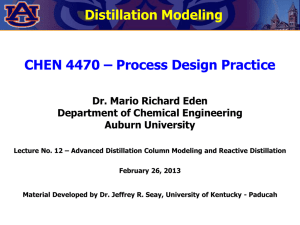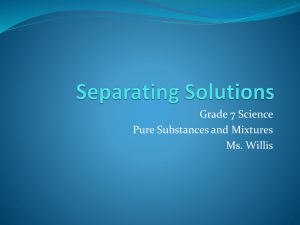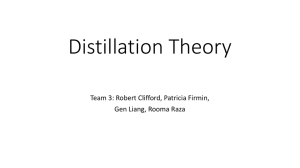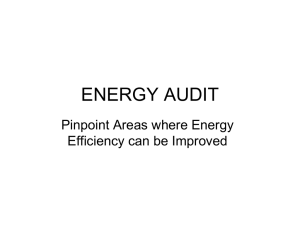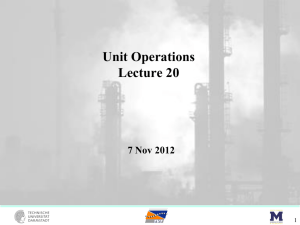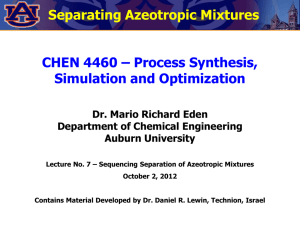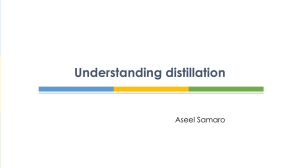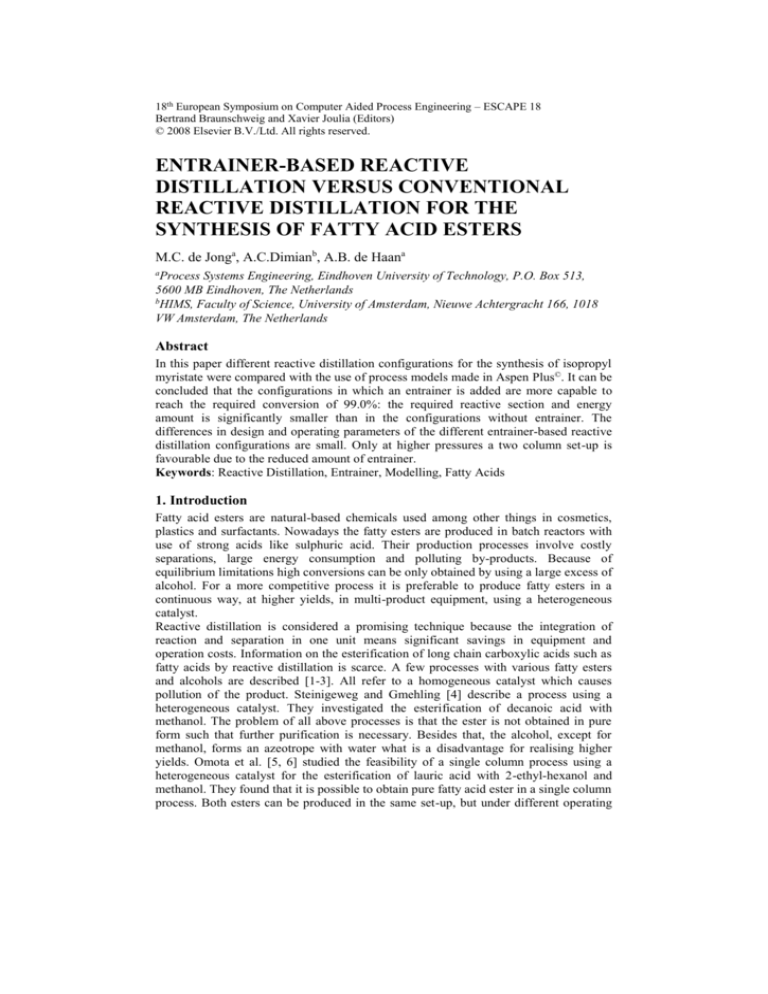
18th European Symposium on Computer Aided Process Engineering – ESCAPE 18
Bertrand Braunschweig and Xavier Joulia (Editors)
© 2008 Elsevier B.V./Ltd. All rights reserved.
ENTRAINER-BASED REACTIVE
DISTILLATION VERSUS CONVENTIONAL
REACTIVE DISTILLATION FOR THE
SYNTHESIS OF FATTY ACID ESTERS
M.C. de Jonga, A.C.Dimianb, A.B. de Haana
a
Process Systems Engineering, Eindhoven University of Technology, P.O. Box 513,
5600 MB Eindhoven, The Netherlands
b
HIMS, Faculty of Science, University of Amsterdam, Nieuwe Achtergracht 166, 1018
VW Amsterdam, The Netherlands
Abstract
In this paper different reactive distillation configurations for the synthesis of isopropyl
myristate were compared with the use of process models made in Aspen Plus©. It can be
concluded that the configurations in which an entrainer is added are more capable to
reach the required conversion of 99.0%: the required reactive section and energy
amount is significantly smaller than in the configurations without entrainer. The
differences in design and operating parameters of the different entrainer-based reactive
distillation configurations are small. Only at higher pressures a two column set-up is
favourable due to the reduced amount of entrainer.
Keywords: Reactive Distillation, Entrainer, Modelling, Fatty Acids
1. Introduction
Fatty acid esters are natural-based chemicals used among other things in cosmetics,
plastics and surfactants. Nowadays the fatty esters are produced in batch reactors with
use of strong acids like sulphuric acid. Their production processes involve costly
separations, large energy consumption and polluting by-products. Because of
equilibrium limitations high conversions can be only obtained by using a large excess of
alcohol. For a more competitive process it is preferable to produce fatty esters in a
continuous way, at higher yields, in multi-product equipment, using a heterogeneous
catalyst.
Reactive distillation is considered a promising technique because the integration of
reaction and separation in one unit means significant savings in equipment and
operation costs. Information on the esterification of long chain carboxylic acids such as
fatty acids by reactive distillation is scarce. A few processes with various fatty esters
and alcohols are described [1-3]. All refer to a homogeneous catalyst which causes
pollution of the product. Steinigeweg and Gmehling [4] describe a process using a
heterogeneous catalyst. They investigated the esterification of decanoic acid with
methanol. The problem of all above processes is that the ester is not obtained in pure
form such that further purification is necessary. Besides that, the alcohol, except for
methanol, forms an azeotrope with water what is a disadvantage for realising higher
yields. Omota et al. [5, 6] studied the feasibility of a single column process using a
heterogeneous catalyst for the esterification of lauric acid with 2-ethyl-hexanol and
methanol. They found that it is possible to obtain pure fatty acid ester in a single column
process. Both esters can be produced in the same set-up, but under different operating
2
M.C. de Jong et al.
conditions. However, problems can occur because of the product purity is highly
sensitive to the reflux ratio. A promising way to improve this is by Entrainer-based
Reactive Distillation (ERD) based on solid catalysts [7].
In ERD in situ separation is used to improve the yield of reaction whereas an entrainer
feed is added to make the separation feasible by selectively increasing the relative
volatility of one of the products. ERD promises to be advantageous for the synthesis of
fatty acid esters. The entrainer increases the relative volatility of water (by-product)
compared to the alcohol (reactant), such that during the reaction the water can be
continuously removed by distillation. In this way the chemical equilibrium is shifted
such that higher conversions can be obtained. In Figure 1 the flowsheet of the desired
process is given, in which
RS stands for Reactive
Make – up
Section and DS for
Entrainer
D
Distillation Section.
entrainer
Water
The conceptual feasibility
DS
Fatty
acid
of ERD for the synthesis of
fatty acid esters is already
R
RS
shown by Dimian et al. [7].
S
This work will concentrate Alcohol
on the gains that can be
obtained using ERD with
Fatty acid ester
regarding to conventional
RD. The objective of this
Figure 1: Conceptual flowsheet for Entrainer-based Reactive
work was to compare
Distillation synthesis of fatty acid esters
several possible process
configurations
from
conventional RD to ERD for the synthesis of fatty acid esters: Conventional RD (one
column), conventional RD (two column), conventional plus azeotropic RD (two
column), ERD (one column) and ERD (two column). The comparison was done by
process models made in Aspen Plus© for the esterification of myristic acid with
isopropanol using a homogeneous catalyst. The models were constructed containing the
necessary conditions (like capacity, conversion and purity) to be able to produce fatty
acid esters. For these conditions, the processes are evaluated in ability to meet these
requirements by comparing column size and energy consumption.
2. Modelling work
2.1. Process conditions and requirements
All the configurations are designed such that a 99.0% conversion of myristic acid and a
99.9% product purity is obtained. The input parameters of the feed streams are based on
a production of 1000 kg/hr (3697 mol/hr) isopropyl myristate and 99% conversion of
the myristic acid. The ratio of myristic acid: ipa was fixed at 1:1.15. The operating
pressures are 1, 5 and 10 bar and in simulations where an entrainer is used, this entrainer
is cyclohexane. The kinetics of the reaction were experimentally determined.
Because the reaction is very slow at atmospheric pressure a large hold-up is required to
reach 99% conversion. For comparison the number of stages is set to 500 and the holdup per stage is varied.
Results are obtain by Aspen Plus© simulations using the NRTL property model with the
NRTL parameters taken from Aspen Plus©.
Entrainer-based Reactive Distillation versus Conventional Reactive Distillation for the
Synthesis of Fatty Acid Esters
3
2.2. Process descriptions
2.2.1. Conventional Reactive Distillation (RD1)
B1
In conventional reactive distillation
only one column is present in which
the reaction takes places. The
myristic acid is fed at the top of the
column and the isopropanol at the
bottom. Between those feed points
the reaction takes place. The
isopropyl myristate is collected at the
bottom and the unreacted myristic
acid and isopropanol will come out
at the top together with the formed
water. The reflux has a high water
content because no water removal
takes places. Therefore a conversion
of 99% is not possible.
TOP
ACID
ALCOHOL
BOTTOM
Figure 2 Process scheme conventional reactive
distillation
2.2.2. Conventional Reactive Distillation with water/alcohol separation (RD2)
B3
B2
3
TOP
2
B1
ACID
1
ALCOHOL
BOTTOM
Figure 3: Process scheme conventional reactive distillation with water/ alcohol separation
In this configuration the conventional reactive distillation column is taken but the top
vapour is condensed and fed into a second column. In this column pure water is drawn
off and an azeotropic mixture of water and isopropanol is recycled back to the reactive
distillation column.
4
M.C. de Jong et al.
2.2.3. Conventional Reactive Distillation combined with Azeotropic Distillation (RD3)
In the conventional reactive distillation
RECYCLE
combined with azeotropic distillation
an azeotropic distillation takes place in
B3
2
the second column. An entrainer is fed
in order to obtain pure isopropanol at
ENTRAINE
WATER
B2
the bottom and a water/entrainer
mixture at the top. The entrainer is
chosen such that it forms an
inmiscibility region with water and the
TOP
mixture can be separated by
decantation. The entrainer phase can be
B1
ACID
recycled back in to the column and the
isopropanol stream is recycled back to
the reactive distillation column.
ALCOHOL
BOTTOM
1
Figure 4 Process scheme conventional reactive distillation
combined with azeotropic distillation
2.2.4. Entrainer-based Reactive Distillation (ERD1)
RECYCLE
TOP
B1
B2
WATER
ENTRAINE
ACID
ALCOHOL
BOTTOM
The entrainer-based reactive
distillation column consists of
a reactive section with a
distillation section placed on
top, in where the entrainer is
responsible for removing the
water out of the reactive
section. The top vapour,
which consists of entrainer,
water and isopropanol, is
condensed and two phases
are
obtained
through
decantation: an aqueous
phase and an entrainer rich
phase which is refluxed back
into the column.
Figure 5 Process scheme entrainer-based reactive distillation
2.2.5. Entrainer-based Reactive Distillation with entrainer/alcohol separation (ERD2)
In this configuration the entrainer-based reactive distillation configuration is taken and
the entrainer rich stream is separated in a second column into a pure entrainer stream
and an alcohol stream.
Entrainer-based Reactive Distillation versus Conventional Reactive Distillation for the
Synthesis of Fatty Acid Esters
5
ENTR
B3
RECYCLE
ALC
B2
WATER
B1
TOP
ENTRAINE
ACID
ALCOHOL
BOTTOM
Figure 6: Entrainer-based reactive distillation with entrainer/alcohol separation
2.3. Results and discussion
In Table 1 the achieved conversion and product purity and the required design and
operating parameters are summarized.
In conventional reactive distillation the desired conversion can not be reached.
However, because the unreacted acid will not end up in the bottom stream, it is possible
to have a product purity of 99.9% which is not the case in the other configurations.
When the conventional reactive distillation is combined with a water/alcohol separation,
there are two extrema; a small reactive column and high amount of energy or a large
reactive column and a low amount of energy.
While the conventional reactive distillation was combined with azeotropic distillation it
appeared that a pure alcohol recycle could only be obtained if the top stream of the
reactive column has a low water content which means a low conversion. So the
azeotropic distillation imposes a constraint on the conversion in the reactive column.
However, a conversion of 99.0% is possible in this configuration but then it is not the
matter of azeotropic distillation anymore. The entrainer ends up in the bottom stream of
the second column and enters therefore the reactive column. Actually this is also a form
of entrainer-based reactive distillation. Looking at this configuration, the entrainerbased reactive distillation and the entrainer-based reactive distillation combined with an
entrainer/alcohol separation it can be seen that the differences in design and operating
parameters are very small. It should be noted that the required hold-up per stage and the
number of stages named in Table 1 are enormously large. Under these operating
circumstances (kinetics, pressure) it is not possible to obtain 99.0% conversion in
reasonable sized equipment.
Table 1: Results overview 1 bar
Conversion [%]
Product Purity [%]
Hold- up reactive stage[l]1)
Reboiler duty [kW]
Condensor/decanter duty [kW]
Nr of separation stages [-]
RD1
RD2a
RD2b
RD3
ERD1
ERD2
64
99.9
81
190
160
-
99
99.4
91
204
931
42)
99
99.0
178
140
58
22)
99
99.0
97
201
124
22)
99
99.0
96
203
118
13)
99
99.0
87
216
181
12)+63)
6
M.C. de Jong et al.
Reboiler duty [kW]
Entrainer amount [mol/hr]
Total energy [kW]
350
813
1948
5
203
8
8100
333
7300
321
59
8900
456
1) hold-up per stage with a total of 500 reactive stages, 2) stages in separate distillation column,
3) stages in distillation section reactive distillation column
In Table 2 the results of the entrainer-based reactive distillation in two columns and in
one column at different pressures can be found. The design and operating parameters do
not differ significantly. Only at higher pressure the two column set-up is more efficient
regarding the requirement entrainer amount.
Table 2: Results overview different pressures
Conversion [%]
Product Purity [%]
Nr of reactive stages[-]
Hold- up reactive stage[l]1)
Reboiler duty [kW]
Condensor/decanter duty [kW]
Nr of separation stages [-]
Reboiler duty [kW]
Entrainer amount [mol/hr]
Total energy [kW]
RD3
1 bar
99
99.0
500
97
201
124
22)
8
8100
333
ERD1
1 bar
99
99.0
500
96
203
118
13)
7300
321
RD3
5 bar
99
99.0
500
17
256
96
82)
5
4000
357
ERD1
5 bar
99
99.0
500
17
256
101
13)
4200
357
RD3
10 bar
99
99.0
380
10
287
87
52)
3
2500
377
ERD1
10 bar
99
99.0
380
10
285
111
13)
4600
397
1) hold-up per stage, 2) stages in separate distillation column, 3) stages in distillation section
reactive distillation column
3. Conclusion
In this paper different reactive distillation configurations for the synthesis of isopropyl
myristate were compared with the use of process models made in Aspen Plus. It can be
concluded that the configurations in which an entrainer is added are more capable of
reaching the required conversion. However the product purity cannot be set higher than
the conversion, they should be equal. The differences in design and operating
parameters of those configurations are small. Only at higher pressures a two column setup is favourable due to the reduced amount of entrainer.
References
1.
2.
3.
4.
5.
6.
7.
Bock, H., G. Wozny, and B. Gutsche, Design and control of a reaction distillation
column including the recovery system. Chem. Eng. Process., 1997. 36: p. 101-109.
Jeromin, L.M., N. Bremus, and E. Peukert, Kontinuierliche veresterung in
Reactionskolonnen. Fette, Seifen, Anstrichmittel, 1981. 83: p. 493-504.
Schleper, B., et al., Einsatz eines eingachen simulationsmodells zur versuchsplanung
fur eine gegenstrom-veresterungskolonne. Chem. Ing. Tech., 1990. 62: p. 226-227.
Steinigeweg, S. and J. Gmehling, Esterification of a fatty acid by reactive distillation.
Ind. Eng. Chem. Res., 2003. 42: p. 3612-3619.
Omota, F., A.C. Dimian, and A. Bliek, Fatty acid esterification by reactive distillation.
Part 1: equilibrium-based design. Chem. Eng. Sc., 2003. 58: p. 3159-3174.
Omota, F., A.C. Dimian, and A. Bliek, Fatty acid esterification by reactive distillation.
Part 2: kinetics-based design for sulphated zirconia catalysts. Chem. Eng. Sc., 2003.
58: p. 3175-3185.
Dimian, A.C., F. Omota, and A. Bliek, Entrainer-enhanced reactive distillation. Chem.
Eng. Process., 2004. 43: p. 411-420.


